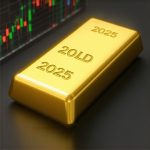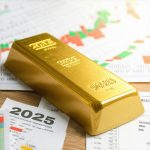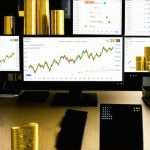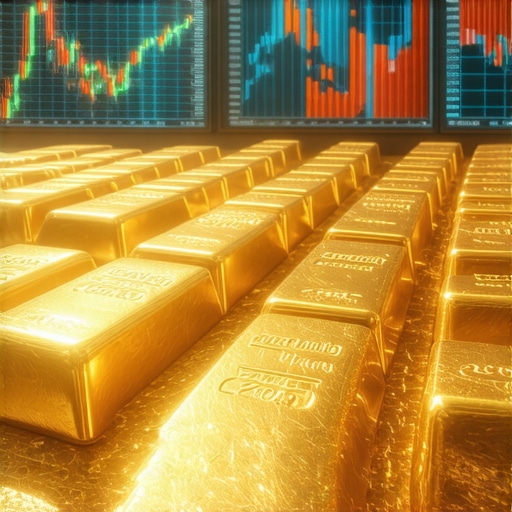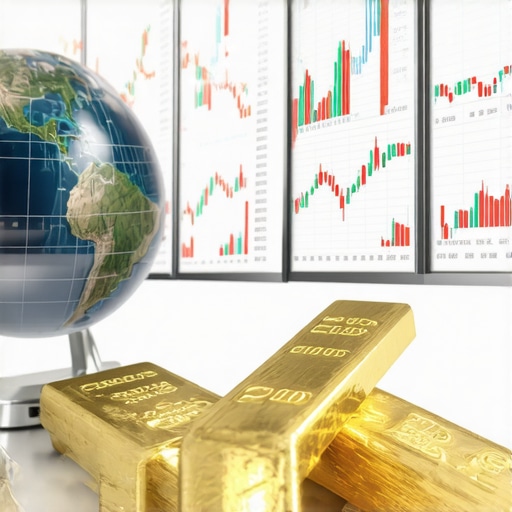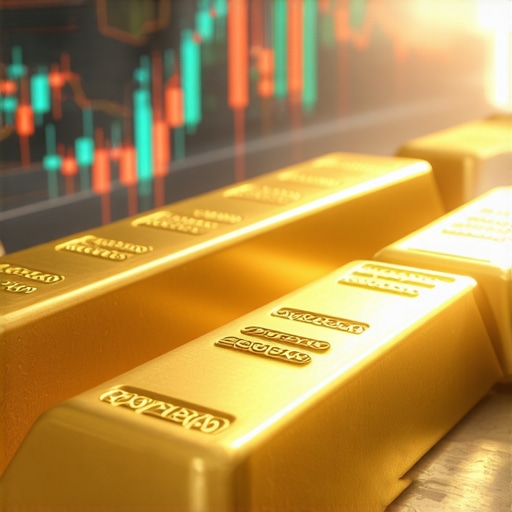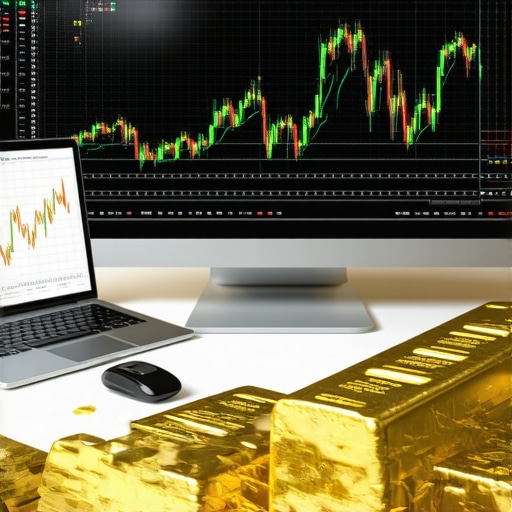Understanding the Nexus Between Global Economic Dynamics and Gold Price Trends in 2025
As an analyst with deep expertise in precious metals markets, I recognize that the trajectory of gold prices in 2025 hinges on a complex interplay of macroeconomic factors. These include inflationary pressures, geopolitical tensions, monetary policies, and emerging market demands. This article delves into how these elements will shape gold’s value, offering a nuanced perspective rooted in financial theory and market data analysis.
Key Economic Indicators Influencing Gold Prices: An In-Depth Perspective
How Will Inflation and Currency Fluctuations Drive Gold Demand?
Historically, gold has served as a hedge against inflation and currency devaluation. In 2025, with global inflation expectations rising due to expansive monetary policies and persistent supply chain disruptions, gold is poised to benefit from increased investor demand. The dollar’s trajectory, influenced by Federal Reserve policies and fiscal deficits, will further modulate gold’s safe-haven appeal. According to the World Gold Council’s recent market data analysis, periods of dollar weakness often correlate with gold price surges.
Geopolitical and Policy-Driven Market Shifts
Geopolitical tensions, especially in resource-rich regions, tend to elevate gold’s status as a safe-haven asset. Political uncertainties in major economies and ongoing trade disputes are likely to maintain high demand for gold in 2025. Additionally, central bank gold purchases, driven by strategic reserves accumulation, will significantly impact market prices. A detailed review of these trends can be found in this comprehensive report.
How Will Emerging Market Economies Shape Gold Market Dynamics?
Emerging markets, particularly in Asia and Africa, are experiencing rapid economic growth, which increases their demand for gold for both investment and jewelry. As these economies expand, their rising middle classes seek gold as a store of wealth, further boosting global demand. This demand, coupled with supply constraints, will influence prices in nuanced ways that only detailed market analysis can predict accurately.
Expert Insights: Can Gold Outperform Traditional Assets in 2025?
While stocks and bonds remain core components of diversified portfolios, expert analysis suggests that gold’s role as an inflation hedge and geopolitical risk mitigator will become increasingly vital in 2025. Strategic allocation, including physical gold and gold-backed ETFs, can provide investors with resilience amidst market volatility. For an advanced investment strategy tailored for 2025, explore expert gold trading strategies.
What are the emerging challenges and opportunities for gold investors in 2025?
Investors should remain vigilant about potential regulatory changes, shifts in monetary policy, and technological innovations in gold extraction and processing. Engaging with professional insights and market analyses will be critical in navigating these dynamics effectively.
Interested in a detailed forecast? Check out comprehensive market predictions for 2025. For community insights and expert opinions, consider participating in forums and industry discussions to refine your investment approach.
Unraveling the Impact of Technological Innovation on Gold Market Strategies in 2025
As technological advancements continue to reshape investment landscapes, gold market participants are increasingly adopting innovative tools and platforms to optimize their portfolios. From blockchain-based trading to AI-driven market analysis, these innovations are transforming how investors approach gold. For instance, blockchain technology not only enhances transparency and security in gold transactions but also facilitates the emergence of digital gold assets, which are gaining popularity among millennials and tech-savvy investors. According to a recent report by industry experts, leveraging these tools can significantly improve trading efficiency and risk management in 2025.
Can Gold Maintain Its Safe-Haven Status Amid Evolving Global Risks?
While gold has long been revered as a safe haven during geopolitical and economic crises, the evolving nature of global risks invites a nuanced debate. The increasing prevalence of cyber threats, climate change-induced disruptions, and geopolitical flashpoints could either reinforce or challenge gold’s safe-haven appeal. For example, cyber warfare might influence digital assets more profoundly, potentially diverting some investor interest away from physical gold. Conversely, persistent geopolitical tensions in regions like Eastern Europe and the South China Sea are likely to sustain demand for traditional gold reserves. Analyzing market data and geopolitical reports reveals that gold’s resilience depends on how these multifaceted risks unfold and how investors adapt their strategies accordingly.
What Are the Emerging Trends in Gold Demand from Sovereign and Institutional Investors?
Sovereign wealth funds and institutional investors are increasingly viewing gold as a strategic reserve and diversification asset. Central banks, in particular, are recalibrating their reserves, with some countries like China and Russia actively increasing their gold holdings as a hedge against dollar devaluation and to bolster national reserves amidst global uncertainties. The trend toward greater official sector participation, as detailed in market analyses, suggests that institutional demand could underpin sustained price support and create new investment opportunities. This shift also influences the broader market dynamics, encouraging retail investors to consider similar diversification strategies.
How can investors leverage advanced analytics and global market insights to navigate gold investment in 2025?
Utilizing sophisticated analytics—such as machine learning models and real-time economic indicators—can provide a competitive edge in predicting short-term price movements and long-term trends. Combining these insights with a thorough understanding of global demand-supply dynamics, geopolitical developments, and monetary policy shifts enables more informed decision-making. Investors should consider integrating tools like comprehensive demand trend reports and market forecasts into their strategies. This approach aligns with expert advice on diversifying across physical gold, ETFs, and mining stocks to optimize returns and hedge against volatility.
Deciphering the Impact of Digital Transformation on Gold Trading Ecosystems in 2025
As the financial landscape continues to evolve at an unprecedented pace, digital transformation emerges as a pivotal factor influencing gold market dynamics. Blockchain technology, decentralized finance (DeFi), and AI-driven analytics are revolutionizing how investors, traders, and institutions engage with gold assets. For example, digital gold platforms backed by blockchain offer unprecedented transparency and security, enabling fractional ownership and seamless cross-border transactions. According to a detailed report by the Blockchain Research Institute, these innovations are not mere technological novelties but foundational shifts that could redefine gold’s role as a monetary and investment asset in 2025 and beyond.
Furthermore, AI algorithms leveraging big data facilitate real-time market sentiment analysis, enabling traders to anticipate price movements with heightened precision. This convergence of technology and market intelligence demands that investors develop a dual competency: understanding traditional fundamentals and mastering digital tools. Embracing these innovations can lead to more resilient and adaptive investment strategies, especially in volatile environments.
What are the critical considerations for integrating blockchain and AI into gold investment portfolios?
Investors should evaluate the regulatory landscape, technology security protocols, and the liquidity profiles of digital gold assets. Additionally, aligning these digital strategies with traditional holdings—such as physical gold and ETFs—can optimize diversification and risk mitigation. For a comprehensive guide, explore expert insights on digital gold integration.
Emerging Geopolitical Risks and Their Strategic Implications for Gold Holders in 2025
While traditional geopolitical tensions continue to influence gold prices, the landscape is becoming increasingly complex with the emergence of cyber warfare, climate-related disruptions, and shifting alliances. For instance, cyber attacks targeting financial infrastructure could undermine confidence in fiat currencies, thereby strengthening gold’s appeal. Conversely, climate-induced supply chain disruptions may impact gold mining operations, constraining supply and elevating prices.
Additionally, the strategic moves by national governments—such as increased gold reserves or gold-backed digital currencies—must be closely monitored. These developments underscore the importance of sophisticated geopolitical risk assessment models, incorporating not just regional conflicts but also cyber and environmental threats. As detailed in the Global Risk Analysis report, proactive risk management becomes indispensable for safeguarding and optimizing gold investments amidst these multifaceted threats.
How can investors hedge against geopolitical and technological risks in their gold portfolios?
Implementing layered risk mitigation strategies—such as diversification across physical gold, digital assets, and non-correlated assets—can buffer against systemic shocks. Incorporating geopolitical risk indices and cyber threat assessments into portfolio management tools enables more dynamic and responsive positioning. For tailored tactics, consult advanced hedging techniques for precious metals.
Harnessing Quantitative Models for Precise Gold Price Forecasting in 2025
Quantitative modeling, leveraging machine learning, Bayesian inference, and econometric analysis, offers unprecedented predictive capabilities. By assimilating vast datasets—ranging from macroeconomic indicators, supply chain metrics, to sentiment analysis—these models can identify subtle patterns and emerging trend shifts. For instance, neural networks trained on multi-year market data have demonstrated superior accuracy in short-term price forecasting, providing traders with actionable signals.
However, these models require continuous refinement and validation against real-world outcomes. Integrating domain expertise with advanced analytics ensures more robust forecasts, enabling strategic positioning in anticipation of market movements. To deepen your understanding, review cutting-edge research on quantitative gold forecasting.
What are the limitations of current predictive models, and how can they be addressed?
While powerful, models are susceptible to overfitting, data quality issues, and unforeseen geopolitical shocks. Addressing these challenges involves diversifying modeling approaches, incorporating stress testing, and maintaining agility in strategy adjustments. Collaborative efforts between data scientists and market experts are essential for maintaining model relevance and accuracy. Engage with industry forums and ongoing research projects to stay ahead of these developments.
Deciphering the Role of Digital Gold Assets in Modern Portfolio Diversification
As the financial ecosystem evolves, digital gold assets—secured by blockchain technology—are emerging as a transformative force. These fractionalized digital assets enable investors to diversify holdings seamlessly across borders, with enhanced transparency and security. According to a comprehensive study by the Blockchain Research Institute, integrating digital gold into traditional portfolios can mitigate risks associated with physical storage and geopolitical disruptions, while offering liquidity advantages in volatile markets.
What are the nuanced implications of monetary policy shifts for gold valuations?
Central banks’ monetary strategies—particularly quantitative easing, interest rate adjustments, and currency interventions—directly influence gold prices. An in-depth analysis by the Federal Reserve’s official reports underscores that expansionary policies often weaken fiat currencies, thereby bolstering gold’s appeal as a hedge. Conversely, tightening measures may reduce investor demand for gold, emphasizing the importance of real-time policy monitoring for strategic positioning.
How can investors leverage artificial intelligence for predictive market insights?
AI-driven analytics—using neural networks, sentiment analysis, and anomaly detection—offer unparalleled precision in forecasting short-term price movements. Platforms integrating machine learning models trained on macroeconomic indicators, geopolitical news, and market sentiment data can identify subtle signals often overlooked by traditional analysis. For example, firms like Quant Research demonstrate that combining AI with expert judgment enhances forecast reliability, equipping investors with a competitive edge in timing entry and exit points.

Assessing the Impact of Environmental, Social, and Governance (ESG) Factors on Gold Mining Operations
Growing emphasis on ESG criteria is reshaping gold mining practices. Technological innovations such as remote sensing, environmental monitoring sensors, and blockchain-enabled supply chain transparency are fostering sustainable mining initiatives. According to a report by Sustainable Mining Alliance, integrating ESG considerations not only aligns with regulatory trends but also enhances brand reputation and investor trust, ultimately influencing gold supply and market stability.
What are the sophisticated hedging techniques to mitigate systemic risks in gold investments?
Advanced hedging strategies involve a combination of options, futures, and inverse ETFs tailored to specific risk profiles. Implementing dynamic hedging models—guided by real-time volatility metrics and geopolitical risk assessments—can significantly reduce downside exposure. For detailed methodologies, consult Expert Hedging Strategies, which provides actionable insights into constructing resilient gold portfolios amidst unpredictable global shifts.
Expert Insights & Advanced Considerations
Strategic Diversification Remains Paramount
In 2025, sophisticated investors recognize that diversifying across physical gold, ETFs, and digital assets mitigates systemic risks and enhances portfolio resilience. Leveraging these channels in tandem allows for optimal risk-adjusted returns amidst volatile market conditions.
Technological Innovation as a Market Catalyst
Blockchain-based gold trading platforms and AI-driven analytics are revolutionizing market transparency and predictive accuracy. Embracing these tools can provide a competitive edge, enabling proactive decision-making and safeguarding investments against unforeseen disruptions.
Geopolitical and Environmental Risks Demand Vigilance
Cyber threats, climate change impacts on mining operations, and shifting geopolitical alliances underscore the importance of dynamic risk assessment. Incorporating real-time geopolitical risk indices into strategy formulation is essential for maintaining an adaptive investment posture.
Emerging Market Demand as a Long-Term Driver
Rising middle classes in Asia and Africa continue to propel gold demand for both jewelry and investment. Monitoring these trends offers insights into future price trajectories and potential entry points for strategic positioning.
Digital Gold Assets as a Future Standard
Blockchain-secured fractionalized gold tokens are gaining traction, providing liquidity and ease of cross-border transactions. Integrating digital gold into traditional portfolios enhances diversification and operational flexibility.
Curated Expert Resources
- World Gold Council: The authoritative source for comprehensive market data and trend analysis, essential for informed decision-making.
- Blockchain Research Institute: Pioneering insights into blockchain applications in gold trading, crucial for understanding digital asset integration.
- Sustainable Mining Alliance: Leading reports on ESG practices, vital for assessing supply chain risks and sustainability considerations.
- Federal Reserve Economic Data (FRED): Real-time macroeconomic indicators and policy updates influencing gold valuations.
- Quant Research: Advanced analytics and AI-driven market forecasting tools, indispensable for predictive modeling and strategic planning.
Final Expert Perspective
In 2025, mastering the nuances of gold investment requires a blend of technological acumen, geopolitical awareness, and strategic diversification. The evolving landscape underscores the importance of leveraging authoritative resources and innovative tools to navigate complexities successfully. For professionals committed to excellence, continuous engagement with industry insights and advanced analytics remains the cornerstone of sustained success in gold markets. To deepen your expertise, explore our comprehensive resources and share your perspectives—collective knowledge is the key to unlocking future opportunities.
